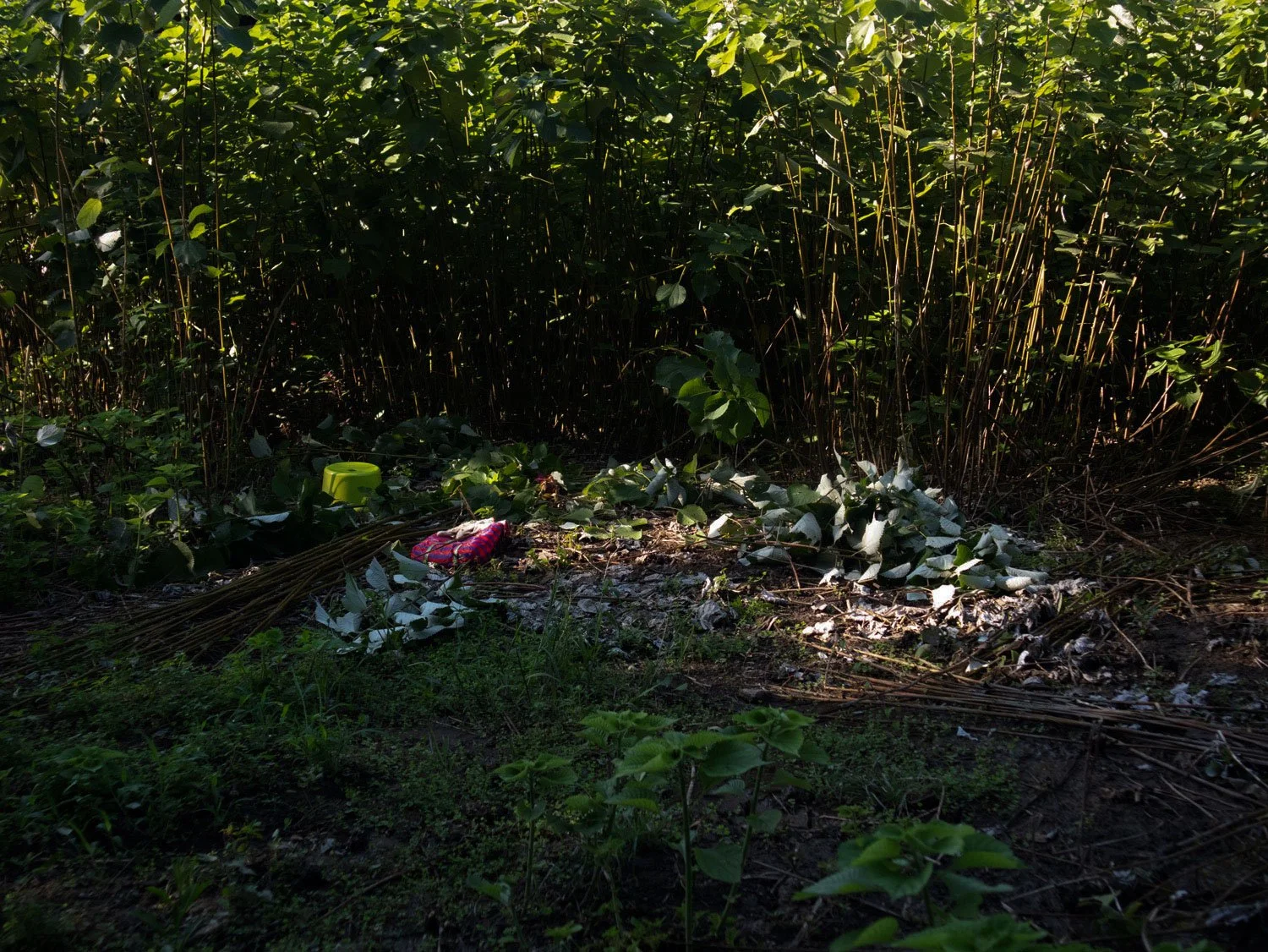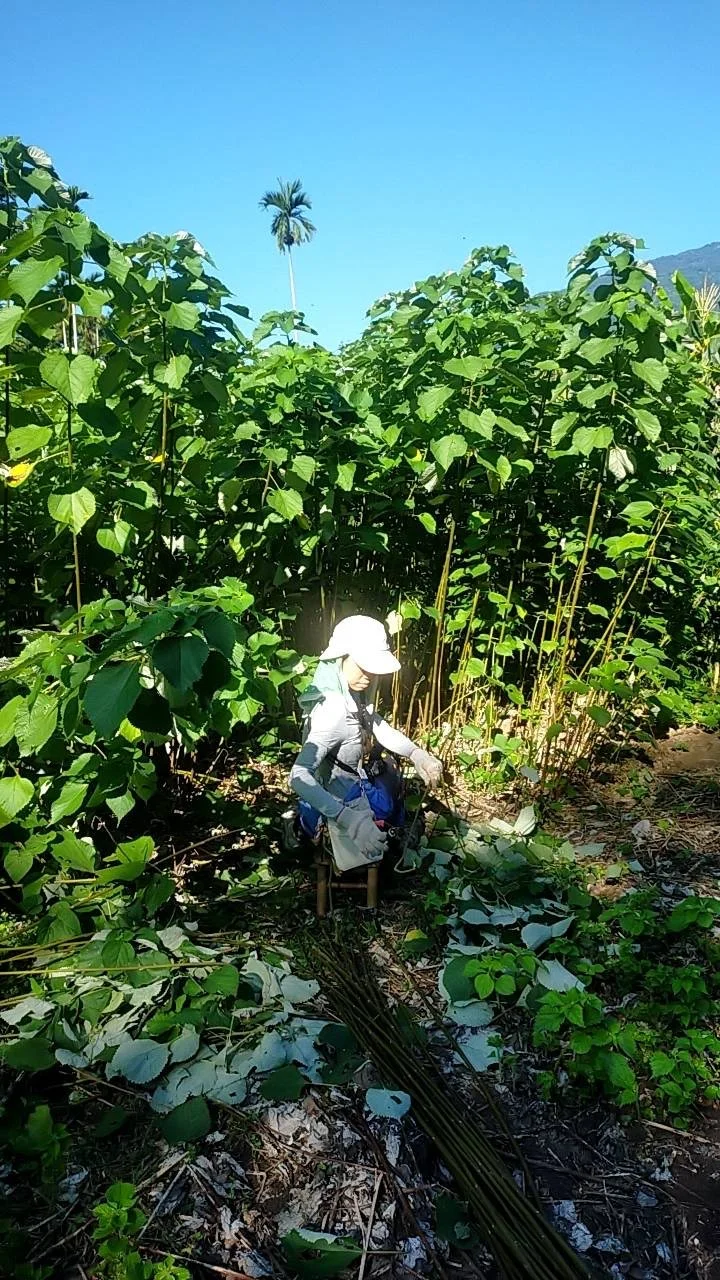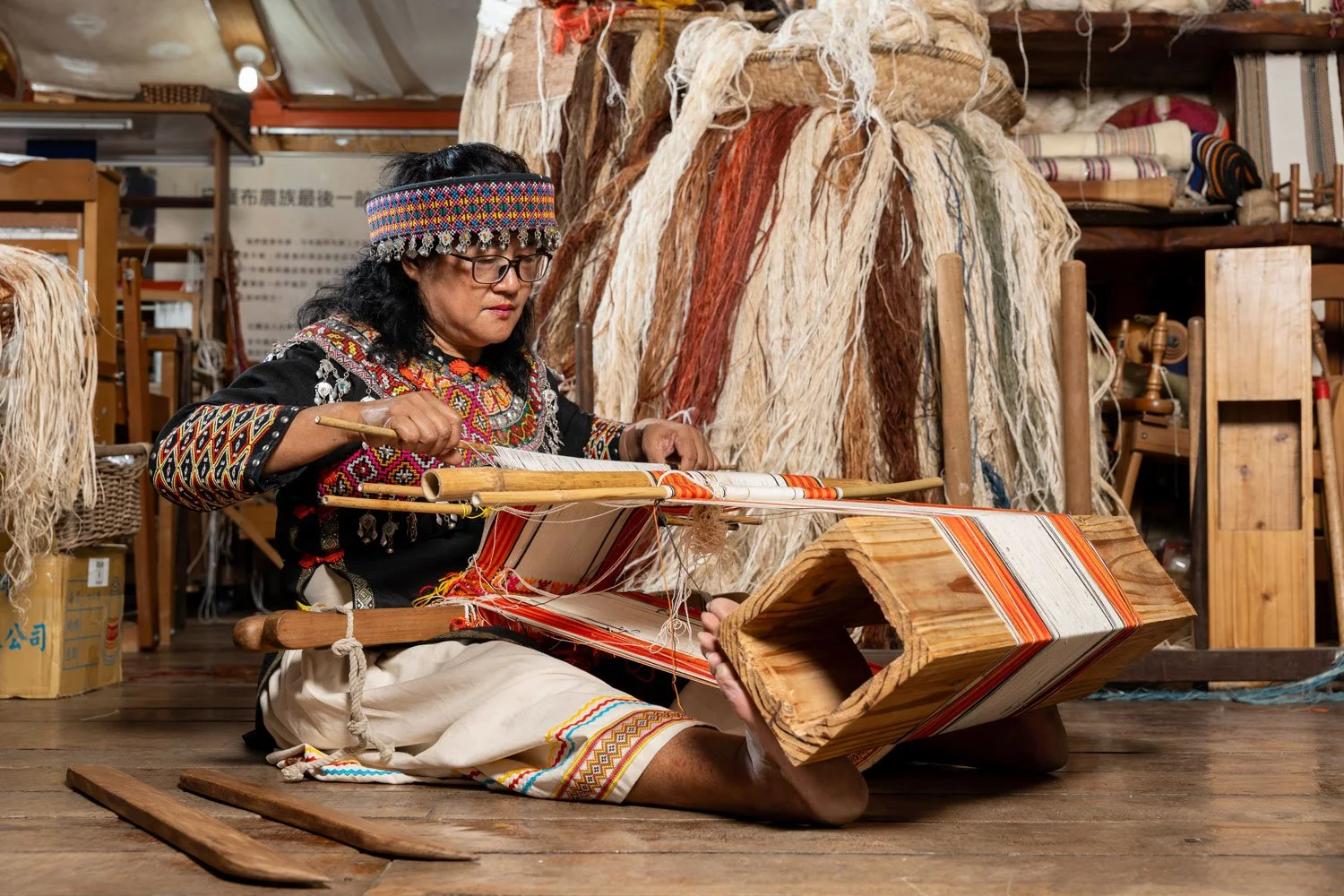30 days is incredibly short, when you’re in a completely new environment. During my residency in Chile, I managed to complete 2 new artworks within 3 weeks, and that included all the time spent on frequent field trips to locations off the lodgings. Yet, this time, I was too busy living life. Listening to people talk about the history of the area and the aborigines, experiencing local life with my teacher and her family, taking the very important afternoon naps while the 35 degree afternoon sun raged outside.
Abus and me in her studio / Photo credit: #南島漣藝
I arrived in Taitung on 16 June for my residency with Art Ripple Taitung at the studio of Abus, who was to be my teacher for the next 30 days. She is a Taiwanese aborigine of the Bunun tribe, 1 of the (nationally recognised) 16 tribes in Taiwan, and specialises in Ramie fibre and weaving. The provided lodging was a guesthouse run by her family, literally 10 steps from the studio, making my life there incredibly convenient— perhaps too much, for I wasn’t very keen to leave the radius around her home.
With the knowledge that I would have to make 2 artworks that would be exhibited in Singapore for the FIND Design Fair in September, I had a hard time deciding what exactly I wanted to learn. Thankfully, Abus has a ‘go-with-the-flow’ energy, and I’d just have to express some scattered thought for her to immediately start sharing her knowledge. That became my main goal: to learn as much as possible, and understand the materials I got exposed to.
RAMIE: PLANT TO FIBRE
Prior to arriving, I was mainly interested to know how Ramie was processed from plant to yarn. When I started exploring vessel forms in 2021, I had opted for nylon fibre due to its given capability of melting; even so, my inclination towards natural fibre has always been present.
Photo of ramie yarns in Abus’ backyard
I think everyone can agree that one of the main features of textile art is its time-consuming process. Crochet, knitting, stitching, are all incredibly time-consuming, and even more so if you decide to spin your own yarn from fibre before that. I’ve always appreciated this process, because it gives you the opportunity to interact with the fibre and understand its characteristics; in fact, my exhibition in Kyoto in May highlighted this— the seemingly unnecessary manual work in textile, which in fact makes all the difference. However, I’d always just bought the fibre from shops, then started from there. I never thought that I’d have the opportunity to experience going one step backward and beginning from the plant.
View of the ramie field belonging to Abus
It wasn’t just the act of processing the fibre that took time though; there was a lot of inactive time— waiting. When you have a time-consuming action you aren’t so aware of time moving along, but I feel waiting is what really tests my patience. It forces you to rest, and my time in Taitung taught me that Nature always takes her time, and there’s nothing you can do except to let it come when it is ready.
The sun in Taitung rises really early, and hot; so Abus needs to start harvesting Ramie from about 6-7am. They also grow vegetables for their own consumption in the same plot as the ramie, and have a custom of trading vegetables and fruits with other friends around Taiwan. I harvested about 20 stalks of ramie for my artwork by hacking at the base of the stalks (which towered over me!), then removing the leaves. The ramie can only be harvested during this time of the year.
We then transport the stalks back to the workroom, where we peel the outer layer off the core. The outermost layer (epidermis) is unwanted and scraped off, turning the fibre mostly pale. If the fibre is to be softer and dyed, the fibre is then flipped around and scraped on the back, to remove the gummy substance on the other side, which is green. If both sides are scraped clean, the fibre becomes beautifully pale, and is ready for soaking. In the photo below, you can see how little fibre I got from 20+ stalks of ramie, because I wasn’t very good at scraping them.
Abus keeps a stash of wood ash, which she sifts into a basin of water. When the sediment settles, the water is used to soak the fibre overnight. This is the first period of waiting! The next day, we take it out and hang it to dry. This process is longer, and takes about 3-5 days; the fibre sits in the sun and rain (if any), turning whiter and whiter.
DYEING RAMIE FIBRE
During the wait for this batch of fibre, which I intend to dye yellow with turmeric, I work on spinning another batch of fibre Abus has pre-dyed with 薯莨 (Dioscorea matsudae Hayata), a plant from the Yam family. A similar plant exists in Japan, but grows underground; the one in Taitung grows just above the ground, but high up in the mountains. Abus usually relies on younger folk who go hunting in the mountains to pick these up for her.
Abus mentioned that this plant is highly sought after because it adds strength to thread. Apparently, they used to dye yarn with this for fishing before nylon existed. It was so precious that the Japanese got the locals to harvest them during colonial rule, and had them shipped to Japan. I was particularly taken with the different rich shades of brown, and thus decided to use it in my artwork.
I didn’t realise till this residency how ‘lazy’ I have actually been in my fibre preparation. I usually just grab my roving (if wool) or fibre (if flax or similar) from the bag as I spin. Ramie, however, is very long (as you saw the stalks in the photo above), and not preparing them beforehand would result in a lot of tangling. In the picture above, I have separated them into strands of similar thickness, ready to be spun. Looks easy but took hours!
The above photos show turmeric we dug from Abus’ garden, which then had their skins removed before grating. The dyeing process is ‘dry’; it doesn’t require boiling or fixing. The juices from the grated turmeric was mixed with a little water before massaging the fibres in for 10 minutes, 3 times with 10 minutes between each round. For a lighter yellow, I also did one batch with 2 rounds of dyeing and extra drying time in the sun!
Three shades of turmeric yellow; yarn loosely spun on machine.
As I have always worked with a yarn spindle, I was surprised when I saw Abus plying string with just her hands and thigh. She holds 2 lengths of ramie fibre, then rubs them forward on her thigh to create an S-twist; then she rolls them towards herself without letting go, so they overlap on a Z-twist. It’s so simple and ingenious.
The hand-plied string has a clear difference though— it is much stiffer, so Abus does not use it for weaving. The threads to be woven has to be loosely twisted (this isn’t possible for shorter fibres like certain wool or cotton), so Abus uses a modern yarn spinner though she also owns a hand spindle.
My hand-plied yarn— look at the twist! It’s nowhere near as nice as Abus’ though.
月桃 Yue Tao(Shell Ginger)
Another material I was very intrigued by was Yue Tao, due to its many uses in the community. Originally, the Bunun people used rattan for most of their weaving as they needed something more hardy for their activities. However, when they moved down from the mountains, they got exposed to Yue Tao, which was more used in the Amis tribes. The leaves can be used for wrapping dumplings, and the layers of stalk for woven bags, mats, and more. Stripping the side of the stalks also produces a long fibre which can be twisted into string.
The Yue Tao has to be removed from the plant (it is in layers, similar to the ginger plant) while it is green, then rolled up as in the image to dry for a few days. Once it has turned brown, it will be ready for use. You can introduce some moisture to the strips and pull at them with your thumb to straighten them out, then split them into the desired width. However, the time it is harvested also makes a difference. Harvesting between October to February (in Taiwan) yields fibre that is much more pliant and less susceptible to splitting.
羊角鉤 Goat-horn hook
This is one of the traditional tools used to create a mesh-like structure, often used for bags by the Taiwanese aborigines. In fact, you can even find similar knotting techniques in Thailand or Vietnam, though the style of the bag and tool might differ. These ones are made in wood, with an area in the middle similar to a bobbin for loading string. The back of it is shaped like a mushroom, so it’s easier to pass the hook through when knotting, and the other end has a goat’s horn attached to it. Sometimes, they use a penknife to shave down the horn so it has a finer tip, or create an indent for easier use. The modern versions have a crochet hook instead of a horn attached, which makes it slightly easier. I’m currently still practicing with it and seeing how far I can go!
Since I didn’t take a photo of the bag there, here is a photo of me with one I bought. The V-shaped dip in the middle is characteristic of the Bunun crossbody bag. This bag can take quite a lot of weight and does not unravel if broken at a certain spot, unlike crochet bags.
This shape is a little more unique; the loops at the top allows the user to hang it directly on small tree branches to create temporary storage, or even to put your baby in while rocking them like in a cradle!
Weaving
Unfortunately, I did not progress into the more complicated looms due to a lack of time, but I did try my hand at the inkle loom!
First belt I wove on the inkle loom, in a simple plain weave
Weaving with the local children, who are here in Abus’ workshop to weave their own headbands for the traditional Bunun costume
We also had 2 French students who took up the challenge of trying out the most traditional floor loom, so I could pick up some knowledge theoretically since I was helping to translate. This made me realise how much patience and focus is required of a weaver, and I truly have a newfound respect for them. Unlike crochet, which runs along a single thread and can be edited at any point, a single mistake made during the preparation of weaving might carry on in the rest of the fabric if not edited. In that way, it is quite an unforgiving medium, and requires 100% attention during the preparation.
Abus in her traditional Bunun outfit, weaving on the floor loom made out of a hollow wooden box and a few bamboo poles / Photo credit: #南島漣藝
Going through this post, I realised how much I’d actually experienced in the 30 days in Taitung, even if I haven’t ‘achieved’ much. It truly is the beauty of creating textile art: the slowness, and time hidden in detail. Looking forward to sharing more about the 2 artworks going to be exhibited at the FIND Design Fair in September, and more video and photo footage of my wonderful experience.
It was a truly humbling experience, going back to the roots of living; crafts borne out of a necessity and function, by human hands. I am grateful to the Art Ripple Taitung team, and Abus and her family for being so generous with me. I can’t wait to go back to Taitung, where beauty, kindness, and so much craft awaits!
From left: Yu Ting from Art Ripple Taitung, Abus, and me / Photo credit: #南島漣藝



























